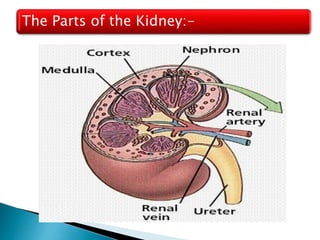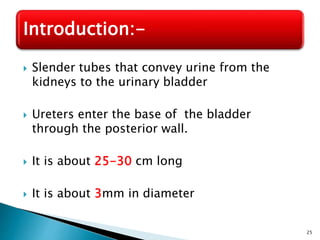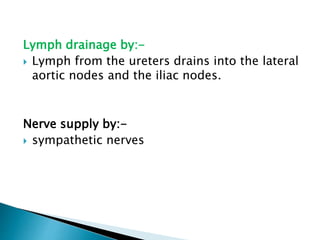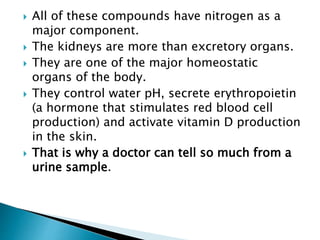ppt on Excretory system akki
- 2. Excretory System – removes excess water, urea, carbon dioxide, and other wastes from our blood. Kidneys (Nephron)– filter out excess water and urea Lungs (Alveoli) – filter out carbon dioxide,from the blood. Skin (Sweat glands) – excretes water, as sweat, which contains some trace chemical wastes, including urea. Liver-ammonia Introduction:-
- 3. Types of metabolic wastes:- Waste Produced from Carbon Dioxide Aerobic Respiration Water Aerobic Respiration Salts Metabolic activities Nitrogenous wastes Breakdown of excess Amino Acids & Proteins Types of nitrogenous wastes toxicity Ammonia (NH3) Highly Toxic Urea Moderately Toxic Uric Acid Crystals Minimally Toxic
- 5. The urinary system is the main excretory system & consist of following organs... 2 Kidneys:-Which secrete urine. 2 Ureters:- Which convey urine from the kidney to urinary bladder. 1 Urinary bladder:- Where urine collect & temporary stored. 1 Urethra:- Through which the urine is discharge from the urinary bladder to the exterior.
- 6. Filter 200 liters of blood daily, allowing toxins, metabolic wastes, and excess ions to leave the body in urine. Regulate volume and chemical makeup of the blood. Maintain the proper balance between water & salts, acids & bases Function:-
- 7. Gluconeogenesis during prolonged fasting Production of- Rennin to help regulate blood pressure Erythropoietin to stimulate RBC production Calcitonin -Activation of vitamin D-Increase level of calcium. Prostaglandin-contraction of uterine muscle
- 8. Location:- It occupy the Epigastric, Hypochondriac, lumber & umbilical regions. Vertically they extend from the upper boarder of 12th thoracic vertebra to the centre of the body of 3rd lumber vertebra The right kidney is lower than the left because of liver Kidney (2)-Renal, Nephron:-
- 9. Shape:- It is Bean shaped organ Size:- 11cm long 6 cm wide 3 cm thick Weight:- 150gm in male 135gm in female Colour:- Raddish brown in colour
- 10. The Parts of the Kidney:-
- 11. Each kidney is composed of three sections: ◦ The outer cortex, ◦ The middle part medulla ◦ & the inner pelvis. The cortex (cone-shaped) is where the blood is filtered. The medulla (funnel-shaped )contains the collecting ducts which carry filtrate (filtered substances) to the pelvis. The pelvis is a hollow cavity where urine accumulates and drains into the ureter.
- 12. Nephron
- 13. The filtering units of the kidneys are the nephrons. There are approximately “1” million nephrons in each kidney. The nephrons are located within the cortex and medulla of each kidney. The tubes of the nephron are surrounded by cells and a network of blood vessels spreads throughout the tissue. Therefore, material that leaves the nephron enters the surrounding cells and returns to the bloodstream by a network of vessels.
- 14. Parts of the Nephron:- Each nephron consists of the following parts: Glomerulus- (is a mass of thin-walled capillaries) Bowman’s capsule -(is a double-walled, cup-shaped structure) Proximal tubule- (leads from the Bowman’s capsule to the Loop of Henle) Loop of Henle- (is a long loop which extends into the medulla) Distal tubule - (connects the loop of Henle to the collecting duct) Collecting duct
- 15. Microscopic structure of the kidney (Nephron):-
- 17. Flow of fluid through nephrone Glomerulus (Bowman’s capsule) Proximal convoluted tubule Descending limb of loop of henle Ascending limb of loop of henle Distal convoluted tubule Drain in to collecting duct
- 18. Blood supply in the kidney Renal artery Segment artery Inter lobular artery Afferent arteriole Glomerular capillaries Efferent arterioles Inter lobule vein Segmental vein Renal vein
- 19. 19 Blood and Nerve Supply:- Approximately one-fourth (1200 ml) of systemic cardiac output flows through the kidneys each minute. Arterial flow into and venous flow out of the kidneys follow similar paths The nerve supply is via the renal plexus
- 20. Formation of urine-These are three process involve in the formation of urine ◦ Filtration- (Blood-Nephrone) ◦ Selective reabsorption -(filtrate-Blood) ◦ Secretion (blood Filtrate) Maintain pH of blood. Remove waste & water from the blood Relies hormone Function of kidney:-
- 21. Water- 96% Urea- 2% Uric acid Creatinine Ammonia Sodium Potassium 2% Chloride Phosphote Sulphate Oxalate Composition of urine:-
- 23. 23 Glomerular Filtration Rate (GFR) “ The total amount of filtrate formed per minute by the kidneys”
- 24. Ureters (2)
- 25. 25 Introduction:- Slender tubes that convey urine from the kidneys to the urinary bladder Ureters enter the base of the bladder through the posterior wall. It is about 25-30 cm long It is about 3mm in diameter
- 26. It is continuous with funnel shaped renal pelvis. It passes downwards through the abdominal cavity, behind the peritoneum in front of the psoas muscle in to the pelvic cavity & passess obliquely through the posterior wall of the bladder
- 27. Structure:-
- 28. 28 Wall of ureters is consist of three layers;- Outer layer-Adventitia- of fibrous tissue continuous with the fibrous capsule of the kidney. Middle layer –Muscular-consisting of smooth muscles fiber Inner layer - Mucosa -composed of transitional epithelium.
- 29. Blood supply by:-Ureter receives its arterial blood supply in three different parts, as explained below. Upper part receives its blood supply from renal artery Middle part receives its blood supply from testicular or ovarian artery Pelvic part receives its blood supply from the superior vesical artery Venous drainage by:- The venous blood is drained by veins that correspond to the arteries explained above.
- 30. Lymph drainage by:- Lymph from the ureters drains into the lateral aortic nodes and the iliac nodes. Nerve supply by:- sympathetic nerves
- 31. Propel urine to the bladder via response to Peristaltic contraction of smooth muscle layer. Function of ureter:-
- 33. It is reservoir of urine It is pear shaped but become more oval as it fills with the urine. It is a Smooth, collapsible, muscular sac that temporarily stores urine It lies in the Pelvic cavity Total capacity is about 600ml Introduction:-
- 34. It lies retroperitoneal on the pelvic floor posterior to the pubic symphysis ◦ Males – prostate gland surrounds the neck inferiorly ◦ Females – Anterior to the vagina and uterus
- 35. Structure:-
- 36. 36 The bladder wall composed of 3 layers. Outer layer -of loose connective tissue- containing blood, lymphatic vessels & nerve covered on the upper surface by the peritoneum. Middle layer -Consisting of the interlacing smooth muscle fiber & elastic tissue loosely arranged in 3 layer is called Ditrusor muscle. Inner layer - Mucosa composed of transitional epithelium
- 38. “3” Orifice of bladder wall form a Triangle or trigone. The two orifice on the posterior wall are the opening of the ureters. The lower orifice is opening in to the urethra. The bladder is distensible and collapses when empty As urine accumulates, the bladder expands without significant rise in internal pressure
- 40. Blood Supply by:-Superior & inferior vesical arteries Venous drainage by : Veins from the vesical venous plexus that drain into the internal iliac vein Lymphatic drainage by : Into internal & external iliac lymph nodes. Nerve supply by:- Sympathetic & parasympathetic nerve
- 41. Urethra (1)
- 42. It is a canal extending from the neck of the bladder to the exterior, at the external urethral orifice. It is a longer in male then the female The male urethra has three named regions ◦ Prostatic urethra – runs within the prostate gland ◦ Membranous urethra – runs through the urogenital diaphragm ◦ Spongy (penile) urethra – passes through the penis and opens via the external urethral orifice Introduction:-
- 43. Structure:-
- 44. Male :- It is about “19-20” cm long Female :- it is about “4” cm long & “6” mm in diameter.
- 45. To transport urine from the bladder. To transport the semen (sperm cells and fluid from the seminal vesicles and the prostate) out the tip of the penis Function in male urethra:-
- 46. 26-46 Disorders of Urinary System Renal calculi Urinary tract infections Glomerular disease Renal failure Polycystic kidney disease
- 47. The kidney has other functions but it is usually associated with the excretion of cellular waste such as : 1) urea (a nitrogenous waste produced in the liver from the breakdown of protein. It is the main component of urine) ; 2) uric acid (usually produced from breakdown of DNA or RNA) and 3) creatinine (waste product of muscle action).
- 48. All of these compounds have nitrogen as a major component. The kidneys are more than excretory organs. They are one of the major homeostatic organs of the body. They control water pH, secrete erythropoietin (a hormone that stimulates red blood cell production) and activate vitamin D production in the skin. That is why a doctor can tell so much from a urine sample.
















































